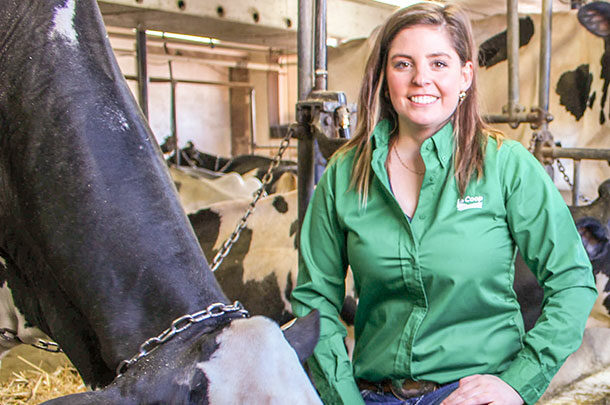It was no surprise I would pursue my studies in agriculture and later on graduate with a bachelor’s degree in animal sciences at Université Laval.
In 2013, I pursued a career as provincial adviser with Holstein Québec, where I developed my skills giving technical support to breeders and guiding them in breeding functional and profitable cows.
Three years ago, I decided to take on a new challenge: being a dairy nutritionist. I wanted to be more involved with on-farm decisions and take part in bringing performance to another level and see results right away.
The job is challenging all right; there never is a day that is the same. Farms all work in their own unique way with different goals in mind, and that is what I love most about my job.
My territory is pretty big, but I plan accordingly. I cover southeast Quebec (where my home farm is located) and eastern Ontario up to the outskirts of Ottawa. Typically, I visit three to four farms a day.
The night before or in the early morning (before leaving with my coffee in hand), I familiarize myself with each farm’s current performance using DFO and DHI results to assess their current situations.
Although I’ve only been a dairy nutritionist for a few years, my experience as a young 4-H’er in taking care of animals at fairs and sales has taught me a lot about dairy cows.
Once I arrive at a farm, I use my five senses and observation skills to examine the ration, manure, cows, rumination, rumen fill, body condition scores and all other technical points that stand out.
Together with the owner and personnel gravitating around the farm, we discuss production, reproductive performances, the upcoming milk planification and any challenges we can foresee. We then look at all of the ingredients that go into the mix for each group of cows and recalculate inventories if need be.
Most of my work is geared towards the cows and youngstock; however, during the summer and fall, I always accompany my clients in guiding them on the right time to harvest, whether it be haylage or corn silage. This way, we can ensure we have all the tools in our toolbox to reach our goals.
All in all, some visits resemble themselves and others do not, but I definitely do not recommend the same decisions for every farm. Depending on the scenario presented on the day of my visit, I like to give two options accompanied by their pros and cons so the farm team can make an informed decision.
I will then go on to my next two to three visits, somewhat repeat the same process and then drive home and work on each of my files. I’ll usually research or reach out for external opinions if need be and send my recommendations to each farm via email.
I like to use Lactascan to analyze the technical-economic performance of the farm on a yearly basis. I find this time of year is great to set goals with our clients, to look back on what we achieved and where we want to be in the next year by comparing ourselves to a group of farms also subscribed to this tool.
Agriculture is fast-evolving, and a lot of farms are adding innovative technologies such as robots on their farms. Part of my role as a new member of the dairy advisory team was to develop my skills with this technology, become familiar with the different software available and help my team support their clients who are going through robotic transfers or have projects geared towards robotic milking.
A cow is still a cow in a robotic milking system; however, the beauty of working in the world of robots is the abundance of data available and being connected 24-7. (That can also have its downfall; you have to be able to disconnect.) Helping guide robotic herds to higher performance is a lot of fun for me because of all the data available and the analysis you can depict from it.
When I arrive at a robot farm, I usually assess the cow behaviour in the freestall and around the robots, along with all other key points I observe at a conventional herd.
Then I like to sit down and analyze all the reports available to me on the dairy management software and ask myself the following questions: Is the herd within the regular robotics parameters? Are fresh cows getting milked three to four times? Is peak milk optimized? How many milkings per robot? Are lactation curves normal? The beauty of the software is: You have daily results. From that point forward, I see if there is any fine-tuning we can do to optimize farm performance.
For me, it is really important to stay on top of performance measures. As a cooperative, we strive to see our clients excel and reach their goals.
During the winter, I also conduct a group analysis to revisit robot performances, pointing out both technical and economics facts. This project includes prospects to see where we stand and what areas we can improve.
Benchmarking our clients is a way to discover the best performance being achieved. We can then establish the standards we want to achieve as a team, validating our philosophy and strategy. We can always learn from what others do and adapt ideas to our own management system.
Working in agribusiness is extremely challenging; you need to be flexible and prove to be agile when put in front of unexpected situations.
I am thrilled to work with different innovations in our fields that make our business managers reach higher performances. As a dairy adviser, this helps us fine-tune rations and get more out of cows while being cost-efficient. ![]()
PHOTO: Preparation and using analytical tools are the methods Marie-Philip Brisson uses in her role as a dairy nutritionist. Photo provided by Marie-Philip Brisson.
Marie-Philip Brisson is with Coop Unifrontieres.










